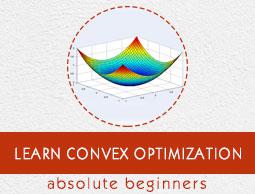Convex Optimization - Polar Cone
Let S be a non empty set in $\mathbb{R}^n$ Then, the polar cone of S denoted by $S^*$ is given by $S^*=\left \{p \in \mathbb{R}^n, p^Tx \leq 0 \: \forall x \in S \right \}$.
Remark
Polar cone is always convex even if S is not convex.
If S is empty set, $S^*=\mathbb{R}^n$.
Polarity may be seen as a generalisation of orthogonality.
Let $C\subseteq \mathbb{R}^n$ then the orthogonal space of C, denoted by $C^\perp =\left \{ y \in \mathbb{R}^n:\left \langle x,y \right \rangle=0 \forall x \in C \right \}$.
Lemma
Let $S,S_1$ and $S_2$ be non empty sets in $\mathbb{R}^n$ then the following statements are true −
$S^*$ is a closed convex cone.
$S \subseteq S^{**}$ where $S^{**}$ is a polar cone of $S^*$.
$S_1 \subseteq S_2 \Rightarrow S_{2}^{*} \subseteq S_{1}^{*}$.
Proof
Step 1 − $S^*=\left \{ p \in \mathbb{R}^n,p^Tx\leq 0 \: \forall \:x \in S \right \}$
Let $x_1,x_2 \in S^*\Rightarrow x_{1}^{T}x\leq 0 $ and $x_{2}^{T}x \leq 0,\forall x \in S$
For $\lambda \in \left ( 0, 1 \right ),\left [ \lambda x_1+\left ( 1-\lambda \right )x_2 \right ]^Tx=\left [ \left ( \lambda x_1 \right )^T+ \left \{\left ( 1-\lambda \right )x_{2} \right \}^{T}\right ]x, \forall x \in S$
$=\left [ \lambda x_{1}^{T} +\left ( 1-\lambda \right )x_{2}^{T}\right ]x=\lambda x_{1}^{T}x+\left ( 1-\lambda \right )x_{2}^{T}\leq 0$
Thus $\lambda x_1+\left ( 1-\lambda \right )x_{2} \in S^*$
Therefore $S^*$ is a convex set.
For $\lambda \geq 0,p^{T}x \leq 0, \forall \:x \in S$
Therefore, $\lambda p^T x \leq 0,$
$\Rightarrow \left ( \lambda p \right )^T x \leq 0$
$\Rightarrow \lambda p \in S^*$
Thus, $S^*$ is a cone.
To show $S^*$ is closed, i.e., to show if $p_n \rightarrow p$ as $n \rightarrow \infty$, then $p \in S^*$
$\forall x \in S, p_{n}^{T}x-p^T x=\left ( p_n-p \right )^T x$
As $p_n \rightarrow p$ as $n \rightarrow \infty \Rightarrow \left ( p_n \rightarrow p \right )\rightarrow 0$
Therefore $p_{n}^{T}x \rightarrow p^{T}x$. But $p_{n}^{T}x \leq 0, \: \forall x \in S$
Thus, $p^Tx \leq 0, \forall x \in S$
$\Rightarrow p \in S^*$
Hence, $S^*$ is closed.
Step 2 − $S^{**}=\left \{ q \in \mathbb{R}^n:q^T p \leq 0, \forall p \in S^*\right \}$
Let $x \in S$, then $ \forall p \in S^*, p^T x \leq 0 \Rightarrow x^Tp \leq 0 \Rightarrow x \in S^{**}$
Thus, $S \subseteq S^{**}$
Step 3 − $S_2^*=\left \{ p \in \mathbb{R}^n:p^Tx\leq 0, \forall x \in S_2 \right \}$
Since $S_1 \subseteq S_2 \Rightarrow \forall x \in S_2 \Rightarrow \forall x \in S_1$
Therefore, if $\hat{p} \in S_2^*, $then $\hat{p}^Tx \leq 0,\forall x \in S_2$
$\Rightarrow \hat{p}^Tx\leq 0, \forall x \in S_1$
$\Rightarrow \hat{p}^T \in S_1^*$
$\Rightarrow S_2^* \subseteq S_1^*$
Theorem
Let C be a non empty closed convex cone, then $C=C^**$
Proof
$C=C^{**}$ by previous lemma.
To prove : $x \in C^{**} \subseteq C$
Let $x \in C^{**}$ and let $x \notin C$
Then by fundamental separation theorem, there exists a vector $p \neq 0$ and a scalar $\alpha$ such that $p^Ty \leq \alpha, \forall y \in C$
Therefore, $p^Tx > \alpha$
But since $\left ( y=0 \right ) \in C$ and $p^Ty\leq \alpha, \forall y \in C \Rightarrow \alpha\geq 0$ and $p^Tx>0$
If $p \notin C^*$, then there exists some $\bar{y} \in C$ such that $p^T \bar{y}>0$ and $p^T\left ( \lambda \bar{y} \right )$ can be made arbitrarily large by taking $\lambda$ sufficiently large.
This contradicts with the fact that $p^Ty \leq \alpha, \forall y \in C$
Therefore,$p \in C^*$
Since $x \in C^*=\left \{ q:q^Tp\leq 0, \forall p \in C^* \right \}$
Therefore, $x^Tp \leq 0 \Rightarrow p^Tx \leq 0$
But $p^Tx> \alpha$
Thus is contardiction.
Thus, $x \in C$
Hence $C=C^{**}$.


